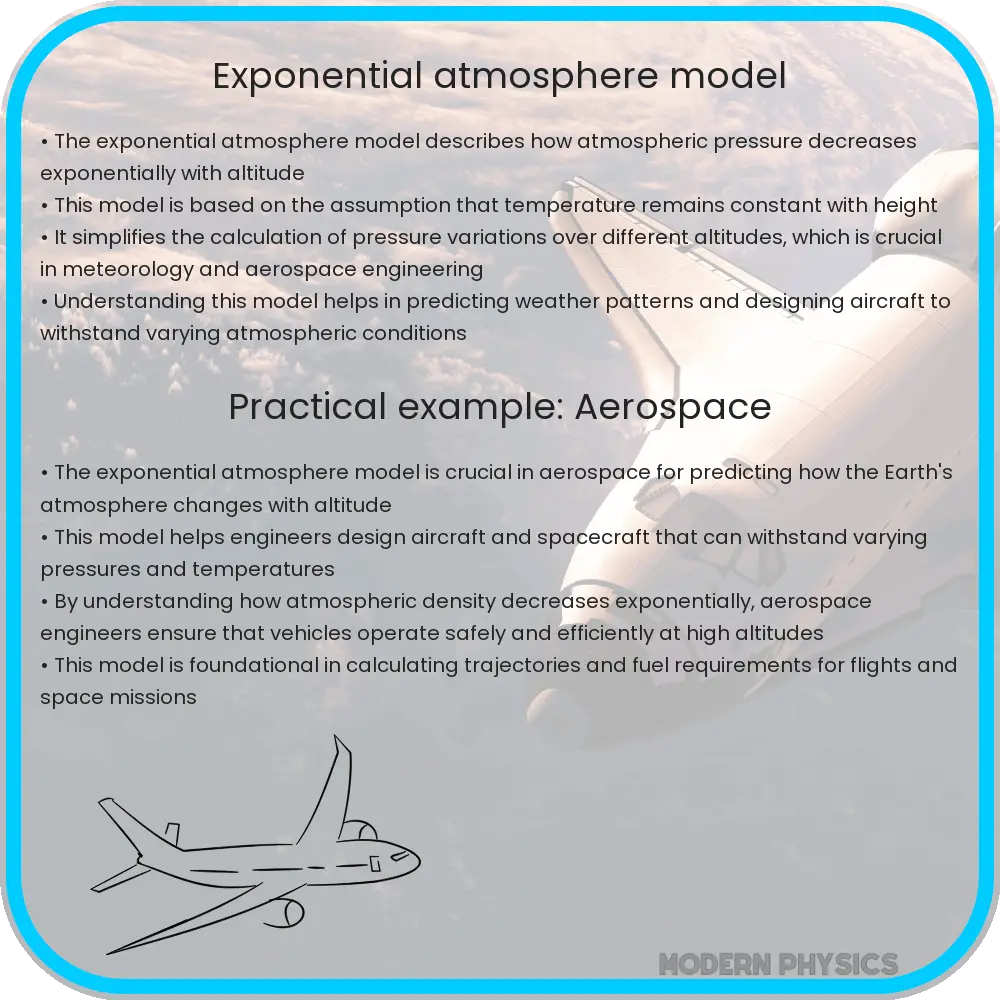Explore the exponential atmosphere model, which simplifies how atmospheric pressure, density, and temperature change with altitude, based on hydrodynamics and thermodynamics principles.

Understanding the Exponential Atmosphere Model
In atmospheric physics, understanding how the density, pressure, and temperature of the atmosphere change with altitude is essential. One of the foundational models used to describe these changes is the exponential atmosphere model, which provides a simplified yet accurate description based on the principles of hydrodynamics and thermodynamics.
Precision and Applications of the Exponential Model
While the exponential atmosphere model assumes a constant temperature, known as the isothermal atmosphere approximation, it remains remarkably precise for many engineering applications. It helps in calculating the behavior of gases in the upper atmosphere, essential for aeronautical engineering, satellite deployment, and even meteorology. The exponential nature of the decrease in atmospheric variables is derived from basic physical laws, catered to by the exponential formula:
- Pressure (P): P = P0 * e-Mgz/RT
- Density (ρ): ρ = ρ0 * e-Mgz/RT
Here, P0 and ρ0 are the pressure and density at sea level, M is the molar mass of air, g is the acceleration due to gravity, z is the altitude, R is the universal gas constant, and T is the absolute temperature.
Hydrodynamics and the Exponential Atmosphere Model
The principles of hydrodynamics play a crucial role in the exponential atmosphere model. By understanding how fluids (in this case, air) behave under varying pressures and temperatures, scientists can predict how these variables change with altitude. This model assumes hydrostatic equilibrium, which states that at any given height in the atmosphere, the downward gravitational force is balanced by the upward pressure gradient force. This is expressed by the hydrostatic equation:
- dP = -ρg dz
This equation integrates to give the exponential form seen in the descriptions of pressure and density above, demonstrating how closely pressure and density are related to altitude in a predictable, exponential manner.
Theory Behind the Model
The theoretical base of the exponential atmosphere model is rooted in the barometric formula, which directly connects atmospheric pressure with altitude. By simplifying atmospheric conditions to an ideal gas under constant temperature, the model uses the universal gas law combined with principles of fluid statics to derive a seamless equation defining how atmospheric characteristics dissipate with altitude. This simplification allows for critical calculations in science and engineering, making the exponential atmosphere model a cornerstone in atmospheric studies.
The precise implications of this model have wide-reaching applications, from calibrating the altimeters in aircraft to optimizing the flight paths of rockets. Each application relies on the fundamental understanding that the atmospheric conditions change exponentially, a principle that remains robust despite simplifications like the assumption of constant temperature.
Limitations of the Exponential Atmosphere Model
Although the exponential atmosphere model is highly effective for many scientific and engineering tasks, it has certain limitations that must be acknowledged. The assumption of a constant temperature across all altitudes, while useful for simplifications, does not hold true in real atmospheric conditions where temperature can vary significantly. These temperature variations can affect the accuracy of pressure and density calculations made using the model.
Moreover, the model does not take into account the humidity or the composition changes in the atmosphere at different altitudes, factors which can also impact the behavior of the atmosphere. These limitations suggest that while the exponential model is a powerful tool for initial calculations and conceptual understanding, more complex models may be necessary for high precision applications, such as detailed climate modeling or the precise navigation of space vehicles.
Future Directions
The exponential atmosphere model serves as a building block for more detailed and complex atmospheric models. Advances in computational power and measurement capabilities continue to refine these models. Future research may incorporate varying temperature gradients, humidity levels, and atmospheric composition into more dynamic systems, increasing the precision of predictions about atmospheric behavior at different altitudes and under various conditions.
Integration of real-time data from satellites and high-altitude sensors promises to enhance model accuracies further, providing a more detailed understanding of our atmosphere and improving applications across meteorology, aviation, and space exploration.
Conclusion
The exponential atmosphere model, despite its simplicity and inherent assumptions, remains a fundamental tool in the study of atmospheric physics. Its ability to simplify the complex interactions of pressure, density, and temperature with altitude provides a valuable framework for numerous practical applications in engineering and science. While the model has its limitations due to assumptions such as constant temperature and uniform gas composition, it forms the backbone of more sophisticated atmospheric models that cater to a wide range of scientific inquiries and technological advancements.
Understanding and applying this model illuminates the ways in which basic physical principles permeate our understanding of the world, showcasing the beauty and utility of physics in deciphering the complex systems that govern our environment. As we continue to refine and expand upon this model, it will undoubtedly play a crucial role in enhancing our capability to predict and manage the atmospheric phenomena that impact our planet.
